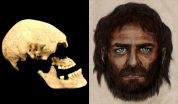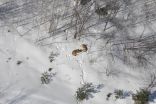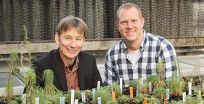(Press-News.org) What if you researched your family's genealogy, and a mysterious stranger turned out to be an ancestor?
That's the surprising feeling had by a team of scientists who peered back into Europe's murky prehistoric past thousands of years ago. With sophisticated genetic tools, supercomputing simulations and modeling, they traced the origins of modern Europeans to three distinct populations.
The international research team published their September 2014 results in the journal Nature.
XSEDE, the Extreme Science and Engineering Discovery Environment, provided the computational resources used in the study. It's a single virtual system that scientists use to interactively share computing resources, data and expertise.
Genomic analysis code ran on Stampede, the nearly 10 petaflop Dell/Intel Linux supercomputer at the Texas Advanced Computing Center (TACC). The research was funded in part by the National Cancer Institute of the National Institutes of Health.
"The main finding was that modern Europeans seem to be a mixture of three different ancestral populations," said study co-author Joshua Schraiber, a National Science Foundation Postdoctoral fellow at the University of Washington.
Schraiber said these results surprised him because the prevailing view among scientists held that only two distinct groups mixed between 7,000 and 8,000 years ago in Europe, as humans first started to adopt agriculture.
Hunter-gatherers with olive skin and mainly blue-eyes first expanded upon the continent about 12,000 years ago, moving north with the retreat of glaciers at the end of the last Ice Age. Later, early European farmers from the Near East migrated west and mixed with the hunter-gatherers. Genetic evidence revealed these farmers had light-colored skin and brown eyes.
The third mystery group that emerged from the data is ancient northern Eurasians. "People from the Siberia area is how I conceptualize it. We don't know too much anthropologically about who these people are. But the genetic evidence is relatively strong, because we do have ancient DNA from an individual that's very closely related to that population, too," Schraiber said.
That individual is a three-year-old-boy whose remains were found near Lake Baikal in Siberia at a site called Mal'ta. Scientists determined his arm bone to be 24,000 years old. They then sequenced his genome, making it the second oldest one yet sequenced of a modern human. Interestingly enough, in late 2013 scientists used the Mal'ta genome to find that about one-third of Native American ancestry originated through gene flow from these ancient North Eurasians.
"I think there was a little bit of luck in this," Schraiber said, referring to the Mal'ta genome. "We knew the models weren't fitting. But we didn't know what was wrong. Luckily, this new ancient DNA had come out."
What scientists did was take the genomes from these ancient humans and compare them to those from 2,345 modern-day Europeans. "I used the POPRES data set, which had been used before to ask similar questions just looking at modern Europeans," Schraiber said. "And then I used a piece of software called Beagle, which was written by Brian Browning and Sharon Browning at the University of Washington, which computationally detects these regions of identity by descent."
The heavy demand on CPU time and RAM caused a bottleneck in the analysis. "Having access to the Stampede supercomputer at TACC was essential for me because at some point I was using a hundred gigabytes of RAM to do something. It took days, even spreading it across multiple processors. It takes a lot of effort to do this identity by descent detection," Schraiber said.
Working on the hunch that the Mal'ta genome might fill in some missing blanks that the modeling pointed out, Schraiber saw a lot more identity by descent between the ancient individuals and modern individuals than he expected. "It made us happy in a lot of ways to find that these are people who share ancestors with modern Europeans."
Schraiber looks to East Asia and Africa as the next hot spots to study human history as scientists push forward to discover and analyze new sources of ancient DNA.
"Using archeological evidence tells you a lot. Modern DNA tells you a lot. But it's by combining the two and getting ancient DNA, which is anthropological evidence and genetic evidence at the same time, you're able to unravel these things. You're able to find complexity that you just didn't know was there before," he said.
INFORMATION:
Reston, Va. (November 11, 2014) - A novel study demonstrates the potential of a novel molecular imaging drug to detect and visualize early prostate cancer in soft tissue, lymph nodes and bone. The research, published in the November issue of the Journal of Nuclear Medicine, compares the biodistribution and tumor uptake kinetics of two Tc-99m labeled ligands, MIP-1404 and MIP-1405, used with SPECT and planar imaging.
Prostate cancer is the most commonly diagnosed non-skin cancer in the United States, and it is second only to lung cancer as the leading cause of cancer ...
If you're a native of rural Mozambique who contracts HIV and becomes symptomatic, before seeking clinical testing and treatment, you'll likely consult a traditional healer.
Your healer may well conclude that your complaints are caused by a curse, perhaps placed upon you by a neighbor or by the spirit of an ancestor. To help you battle your predicament, the healer will likely cut your skin with a razor blade and rub medicinal herbs into the cut.
A recent survey of symptomatic HIV-positive people in rural Mozambique, led by Carolyn Audet, Ph.D., M.A., assistant professor ...
New research from the Johns Hopkins Bloomberg School of Public Health suggests that HIV-infected adults are at a higher risk for developing heart attacks, kidney failure and cancer. But, contrary to what many had believed, the researchers say these illnesses are occurring at similar ages as adults who are not infected with HIV.
The findings appeared online last month in the journal Clinical Infectious Diseases.
Researchers say these findings can help reassure HIV-infected patients and their health care providers.
"We did not find conclusive evidence to suggest that ...
New Haven, Conn.--The phrase "tears of joy" never made much sense to Yale psychologist Oriana Aragon. But after conducting a series of studies of such seemingly incongruous expressions, she now understands better why people cry when they are happy.
"People may be restoring emotional equilibrium with these expressions," said Aragon, lead author of work to be published in the journal Psychological Science. "They seem to take place when people are overwhelmed with strong positive emotions, and people who do this seem to recover better from those strong emotions."
There ...
With both wolf proposals shot down by Michigan voters on election day, the debate over managing and hunting wolves is far from over.
A Michigan State University study, appearing in a recent issue of the Journal of Wildlife Management, identifies the themes shaping the issue and offers some potential solutions as the debate moves forward.
The research explored how different sides of the debate view power imbalances among different groups and the role that scientific knowledge plays in making decisions about hunting wolves. These two dimensions of wildlife management ...
PHILADELPHIA (Nov. 11, 2014) - Federal laws explicitly addressing post-traumatic stress disorder (PTSD) have overwhelmingly focused on the needs of military personnel and veterans, according to a new analysis published in the Journal of Traumatic Stress.
The study, authored by Jonathan Purtle, DrPH, an assistant professor at the Drexel University School of Public Health, is the first to examine how public policy has been used to address psychological trauma and PTSD in the U.S., providing a glimpse of how lawmakers think about these issues.
Purtle found that in federal ...
CHAMPAIGN, Ill. -- When munched by grazing animals (or mauled by scientists in the lab), some herbaceous plants overcompensate - producing more plant matter and becoming more fertile than they otherwise would. Scientists say they now know how these plants accomplish this feat of regeneration.
They report their findings in the journal Molecular Ecology.
Their study is the first to show that a plant's ability to dramatically rebound after being cut down relies on a process called genome duplication, in which individual cells make multiple copies of all of their genetic ...
November 11, 2014--In recent years, many lakes in the upper Midwest have been experiencing unprecedented algae blooms. These blooms threaten fish and affect recreational activities. A key culprit implicated in overgrowth of algae in lakes is phosphorus (P). Lake Pepin, located on the Minnesota/Wisconsin border, has seen increasing phosphorus concentrations over time. Researchers are now trying to identify upstream factors that could explain this increase.
Satish Gupta, a University of Minnesota professor, and Ashley Grundtner, recently published a paper about their research ...
Washington, D.C.--A two-person team of Carnegie's Scott Sheppard and Chadwick Trujillo of the Gemini Observatory has discovered a new active asteroid, called 62412, in the Solar System's main asteroid belt between Mars and Jupiter. It is the first comet-like object seen in the Hygiea family of asteroids. Sheppard will present his team's findings at the American Astronomical Society's Division of Planetary Sciences meeting and participate on Tuesday, November 11, in a press conference organized by the society.
Active asteroids are a newly recognized phenomenon. 62412 ...
How close you are to fast-food outlets may be linked to your risk of Type-2 diabetes and obesity a new study led by the University of Leicester has discovered.
The research found that there was a higher number of fast-food outlets within 500 metres of inner-city neighbourhoods described as non-white as well as in socially deprived areas.
The researchers warn that their findings, based on a study of over 10,000 people, have important implications for diabetes prevention and for those granting planning permission for fast-food outlets.
"Our study suggests that for every ...





